MERCEDES-BENZ S-CLASS CABRIOLET 2019 Owner's Manual
Manufacturer: MERCEDES-BENZ, Model Year: 2019, Model line: S-CLASS CABRIOLET, Model: MERCEDES-BENZ S-CLASS CABRIOLET 2019Pages: 518, PDF Size: 13.78 MB
Page 371 of 518

%
Ifth e automatic transmission cann otbe shif‐
te dto position 005C, orthe multifunction dis‐
play in the instrument clus ter does not show
anything, ha vetheve hicle transpor tedaw ay
( → page 370). A towing vehicle with lifting
equipment is requiredforve hicle transpor ta‐
tion.
* NO
TEDama gedue to to wing away at
exc essively high speeds or over long dis‐
ta nces The driv
etra in could be damaged when tow‐
ing at excessively high speeds or over long
dis tances. #
Atowing speed of 30 mph (50 km/h)
must not be exceeded. #
Atowing dis tance of 30 miles (50 km)
must not be exceeded. &
WARNING Risk of accident when towing
a ve hicle which is too heavy
If th eve hicle being tow- star ted or towed
aw ay is heavier than the permissible gross
mass of your vehicle, thefo llowing situations
can occur:
R The towing eye may become de tach ed.
R The vehicle/trailer combination may
swer veoreve nov erturn. #
If ano ther vehicle is tow- star ted or
to we daw ay, its weight must not exceed
th e permissible gross mass of your own
ve hicle. If a
vehicle must be tow- star ted or towe daw ay,
its weight must not exceed the permissible gross
mass of theto wing vehicle. #
Information on the permissible gross mass of
th eve hicle can be found on theve hicle iden‐
tification plate (→ page 408). #
Do not open the driver's door or front
passenger door, otherwise the automatic transmission automatically shifts
toposition
005D. #
Installth eto wing eye (→ page 372). #
Fasten theto w bar.
* NO
TEDama gedue toincor rect connec‐
tion #
Only connect theto w rope or tow bar to
th eto wing eyes. #
Deactivate the automatic locking mechanism
(→ page 64). #
Do not activate the HOLD function. #
Deactivate Active Brake Assi st (→page 163). #
Shift the automatic transmission toposition
005C. #
Release the electric parking brake. Breakdown assis
tance 369
Page 372 of 518
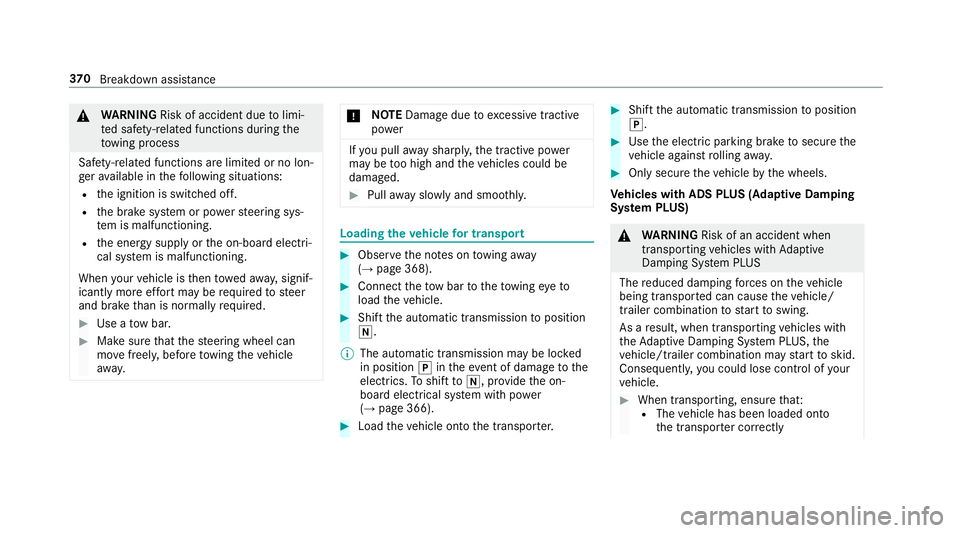
&
WARNING Risk of accident due tolimi‐
te d saf ety-re lated functions during the
to wing process
Saf ety-re lated functions are limited or no lon‐
ge rav ailable in thefo llowing situations:
R the ignition is switched off.
R the brake sy stem or po werst eering sys‐
te m is malfunctioning.
R the energy supply or the on-board electri‐
cal sy stem is malfunctioning.
When your vehicle is then towe daw ay, signif‐
icantly more ef fort may be requ ired tosteer
and brake than is no rmally requ ired. #
Use a tow bar. #
Make sure that thesteering wheel can
mo vefreely, before towing theve hicle
aw ay. *
NO
TEDama gedue toexcessive tracti ve
po wer If
yo u pull away sharpl y,the tractive po wer
may be too high and theve hicles could be
damaged. #
Pull away slowly and smoo thly. Loading the
vehicle for transport #
Obser vethe no tes on towing away
( → page 368). #
Connect theto w bar totheto wing eyeto
load theve hicle. #
Shift the automatic transmission toposition
005C.
% The automatic transmission may be loc ked
in position 005Dintheeve nt of dama getothe
electrics. Toshift to005C , pr ovide the on-
board electrical sy stem with po wer
( → page 366). #
Load theve hicle onto the transpor ter. #
Shift the automatic transmission toposition
005D. #
Use the electric parking brake tosecure the
ve hicle against rolling away. #
Only secure theve hicle bythe wheels.
Ve hicles with ADS PLUS (Adaptive Damping
Sy stem PLUS) &
WARNING Risk of an accident when
transporting vehicles with Adaptive
Damping Sy stem PLUS
The reduced damping forc es on theve hicle
being transpor ted can cause theve hicle/
trailer combination tostart toswing.
As a result, when transporting vehicles with
th eAd aptive Damping Sy stem PLUS, the
ve hicle/trailer combination may start toskid.
Consequentl y,yo u could lose cont rol of your
ve hicle. #
When transporting, ensure that:
R The vehicle has been loaded onto
th e transpor ter cor rectly 37 0
Breakdown assis tance
Page 373 of 518
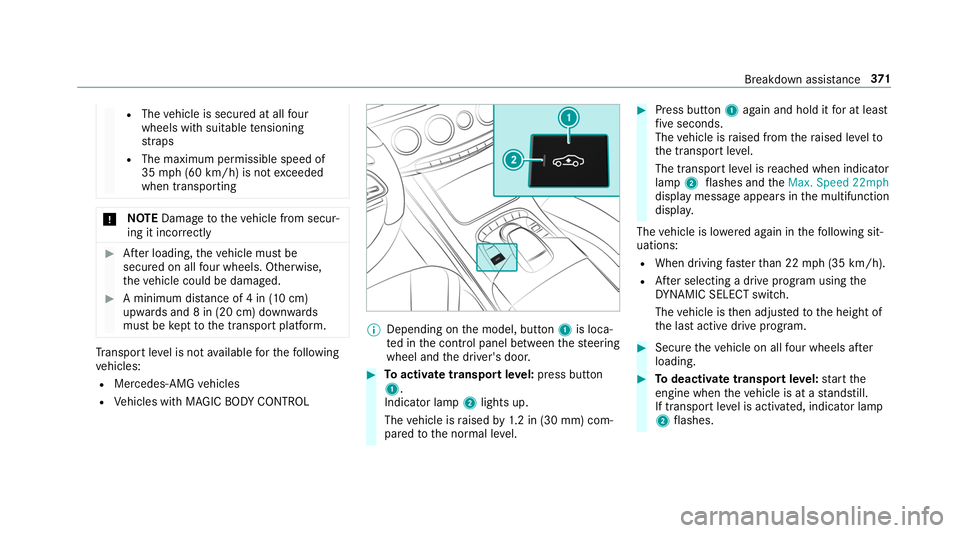
R
The vehicle is secured at all four
wheels with suitable tensioning
st ra ps
R The maximum permissible speed of
35mph (6 0 km/h) is not exceeded
when transporting *
NO
TEDama getotheve hicle from secur‐
ing it incor rectly #
After loading, theve hicle must be
secured on all four wheels. Otherwise,
th eve hicle could be damaged. #
A minimum dis tance of 4 in (10 cm)
up wa rds and 8 in (20 cm) down wards
must be kept tothe transport platform. Tr
ansport le vel is not available forth efo llowing
ve hicles:
R Mercedes-AMG vehicles
R Vehicles with MAGIC BODY CONTROL %
Depending on the model, button 1is loca‐
te d in the control panel between thesteering
wheel and the driver's door. #
Toactivate transpo rtleve l:press button
1.
Indicator lamp 2lights up.
The vehicle is raised by1.2 in (30 mm) com‐
pared tothe normal le vel. #
Press button 1again and hold it for at least
fi ve seconds.
The vehicle is raised from thera ised le velto
th e transport le vel.
The transport le vel is reached when indicator
lamp 2flashes and theMax. Speed 22mph
display message appears in the multifunction
displa y.
The vehicle is lo wered again in thefo llowing sit‐
uations:
R When driving fasterthan 22 mph (35 km/h).
R After selecting a drive program using the
DY NA MIC SELECT switch.
The vehicle is then adjus tedto the height of
th e last active drive program. #
Secure theve hicle on all four wheels af ter
loading. #
Todeactivate transpo rtleve l:start the
engine when theve hicle is at a standstill.
If transpo rtleve l is activated, indicator lamp
2 flashes. Breakdown assis
tance 371
Page 374 of 518

#
Press and hold button 1for at least five
seconds.
The vehicle is adjus tedto the height of the
last active drive prog ram. Indicator lamp 2
goes out. #
Drive theve hicle off the transpor ter. To
wing eyesto rage location To
wing eye1 is located with theve hicle tool kit
under the trunk floor. Installing
theto wing eye #
Press the mark on co ver1 inwa rds and
re mo ve. #
Screw intheto wing eyeclockwise as far as it
will go and tighten.
% Make sure that co ver1 engages in the
bumper when youre mo vetheto wing eye. *
NO
TEDama gedue toincor rect use of
th eto wing eye When a
towing eye is used toreco ver a vehi‐
cle, theve hicle may be damaged in the proc‐
ess. #
Only use theto wing eyeto to waw ay or
to w start theve hicle. To
w- starting theve hicle (eme rgency engine
st art) *
NO
TEDama getothe automatic trans‐
mission due to towstarting The automatic transmission may be damaged
in the process of tow starting vehicles with
automatic transmission. #
Vehicles with automatic transmission
must not be tow star ted. #
Vehicles with automatic transmission must
not be tow- star ted. 372
Breakdown assis tance
Page 375 of 518

Electrical fuses
Note
s on electrical fuses &
WARNING Risk of accident and inju ry
due to ov erloaded lines
If yo u manipulate or bridge a faulty fuse or if
yo ure place it with a fuse with a higher
amperage, the electric line could be overloa‐
ded.
This could result in a fire. #
Alw aysre place faulty fuses with speci‐
fi ed new fuses conta iningthe cor rect
amperage. *
NO
TEDama gecaused byincor rect fuses Incor
rect fuses may cause damage toelectri‐
cal components or sy stems. #
Only use Mercedes-Benz appr oved
fuses with the cor rect fuse rating. Blown fuses mu
stbe replaced with fuses of the
same rating, which you can recognize bythe
color and fuse rating. The fuse ratings and fur‐ th
er information tobe obser ved are lis ted in the
fuse assignment diagram.
* NO
TEDama geor malfunctions caused
by moisture Moisture may cause dama
getothe electrical
sy stem or cause it tomalfunction. #
When the fuse box is open, make sure
th at no moisture can enter the fuse
box. #
When closing the fuse box, make sure
th at the seal of the lid is positioned cor‐
re ctly on the fuse box. If
th e newly inser ted fuse also blo ws, ha vethe
cause traced and rectified at a qualified special‐
ist workshop, e.g. an authorized Mercedes-Benz
Center.
Ensure thefo llowing before replacing a fuse:
R The vehicle is secured against rolling away
R All electrical consumers are switched off
R The ignition is switched off The electrical fuses are located in
thefo llowing
fuse bo xes:
R Fuse box in the engine compartment on the
driver's side (→ page373)
R Fuse box on the driver's side of the cockpit
(→ page 375)
R Fuse box in the front passenger foot we ll
(→ page 375) Opening an
d closing the fuse box in the
engine co mpartment Requ
irements:
R Obser vethe no tes on electrical fuses
(→ page 373).
R Have thefo llowing tools readily available:
- a dry clo th
- a sc rewdriver Breakdown assis
tance 373
Page 376 of 518
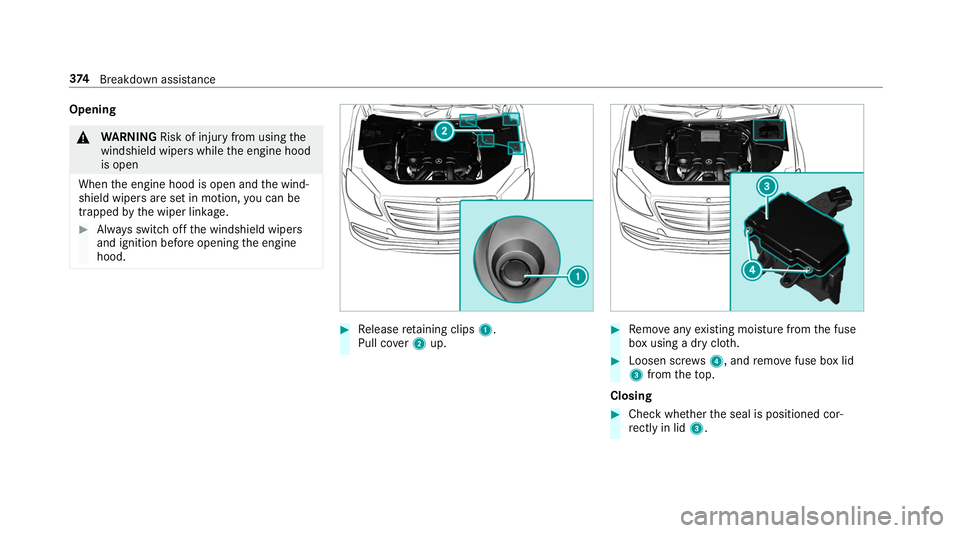
Opening
&
WARNING Risk of inju ryfrom using the
windshield wipers while the engine hood
is open
When the engine hood is open and the wind‐
shield wipers are set in motion, you can be
trapped bythe wiper linkage. #
Alw ays switch off the windshield wipers
and ignition before opening the engine
hood. #
Release retaining clips 1.
Pull co ver2 up. #
Remo veany existing moisture from the fuse
box using a dry clo th. #
Loosen scr ews4, and remo vefuse box lid
3 from theto p.
Closing #
Check whe ther the seal is positioned cor‐
re ctly in lid 3. 374
Breakdown assis tance
Page 377 of 518
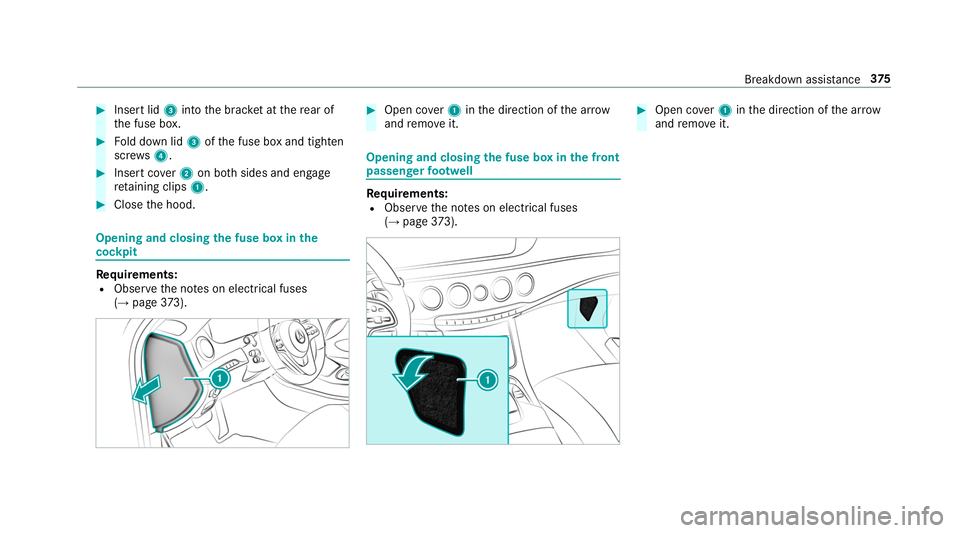
#
Insert lid 3into the brac ket at there ar of
th e fuse box. #
Fold down lid 3ofthe fuse box and tighten
scr ews4. #
Insert co ver2 on bo thsides and engage
re taining clips 1. #
Close the hood. Opening and closing
the fuse box in the
cockpit Re
quirements:
R Obser vethe no tes on electrical fuses
(→ page 373). #
Open cover1 inthe direction of the ar row
and remo veit. Opening and closing
the fuse box in the front
passenger foot we ll Re
quirements:
R Obser vethe no tes on electrical fuses
(→ page 373). #
Open cover1 inthe direction of the ar row
and remo veit. Breakdown assis
tance 375
Page 378 of 518
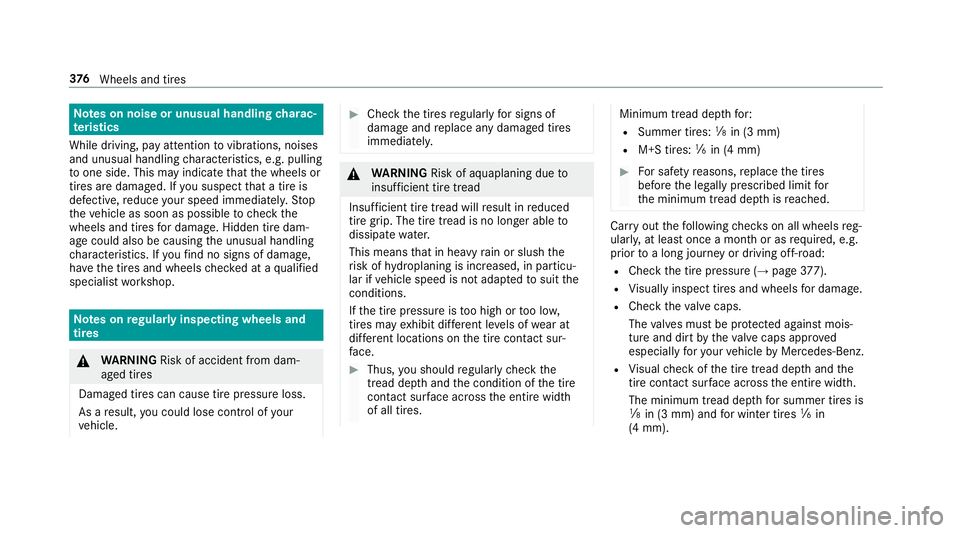
Note
s on noise or unusual handling charac‐
te rist ics
While driving, pay attention tovibrations, noises
and unusual handling characteristics, e.g. pulling
to one side. This may indicate that the wheels or
tires are damaged. If you suspect that a tire is
defective, reduce your speed immediatel y.Stop
th eve hicle as soon as possible tocheck the
wheels and tires for dama ge. Hidden tire dam‐
age could also be causing the unusual handling
ch aracteristics. If youfind no signs of damage,
ha ve the tires and wheels checked at a qualified
specialist workshop. Note
s onregular lyinspecting wheels and
tires &
WARNING Risk of accident from dam‐
aged tires
Dama ged tires can cause tire pressure loss.
As a result, you could lose cont rol of your
ve hicle. #
Check the tires regularly for signs of
dama geand replace any damaged tires
immediatel y. &
WARNING Risk of aquaplaning due to
insuf ficient tire tread
Insu fficient tire tread will result in reduced
tire grip. The tire tread is no longer able to
dissipate water.
This means that in heavy rain or slush the
ri sk of hydroplaning is increased, in particu‐
lar if vehicle speed is not adap tedto suit the
conditions.
If th e tire pressure is too high or too lo w,
tires may exhibit dif fere nt le vels of wear at
dif fere nt locations on the tire conta ct sur‐
fa ce. #
Thus, you should regularly check the
tread de pth and the condition of the tire
conta ct surface across the entire width
of all tires. Minimum tread dep
thfor:
R Summer tires: 00CEin (3 mm)
R M+S tires: 00CFin (4 mm) #
For saf etyre asons, replace the tires
before the legally prescribed limit for
th e minimum tread dep thisreached. Car
ryout thefo llowing checks on all wheels reg‐
ularly, at least once a month or as requ ired, e.g.
prior toa long journey or driving off- road:
R Check the tire pressure (→ page377).
R Visually inspect tires and wheels for dama ge.
R Check theva lve caps.
The valves must be pr otected against mois‐
ture and dirt bytheva lve caps appr oved
especially foryo ur vehicle byMercedes-Benz.
R Visual check of the tire tread dep thand the
tire contact su rface across the entire width.
The minimum tread dep thfor summer tires is
00CE in (3 mm) and for winter tires 00CFin
(4 mm). 376
Wheels and tires
Page 379 of 518
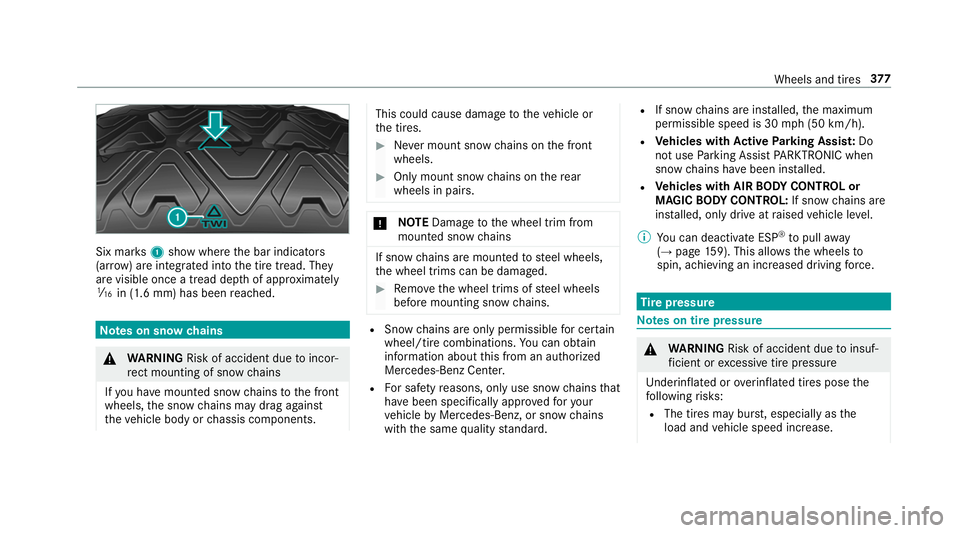
Six mar
ks1 show where the bar indicators
(ar row ) are integrated into the tire tread. They
are visible once a tread dep thof appr oximately
00CD in (1.6 mm) has been reached. Note
s on snow chains &
WARNING Risk of accident due toincor‐
re ct mounting of snow chains
If yo u ha vemounted snow chains tothe front
wheels, the snow chains may drag against
th eve hicle body or chassis components. This could cause damage
totheve hicle or
th e tires. #
Never mount snow chains on the front
wheels. #
Only mount snow chains on there ar
wheels in pairs. *
NO
TEDama getothe wheel trim from
mounted snow chains If sn
ow ch ains are moun tedto steel wheels,
th e wheel trims can be damaged. #
Remo vethe wheel trims of steel wheels
before mounting snow chains. R
Snow chains are on ly permissible for cer tain
wheel/tire combinations. You can obtain
information about this from an authorized
Mercedes-Benz Center.
R For saf etyre asons, on lyuse sn ow chainsthat
ha ve been specifically appr oved foryo ur
ve hicle byMercedes-Benz, or snow chains
with the same quality standard. R
If sn ow ch ains are ins talled, the maximum
permissible speed is 30 mph (50 km/h).
R Vehicles with Active Parking Assis t:Do
not use Parking Assist PARKTRONIC when
sn ow ch ains ha vebeen ins talled.
R Vehicles with AIR BODY CONT ROL or
MAGIC BODY CONT ROL:If sn owchains are
installed, on ly driveatraised vehicle le vel.
% You can deactivate ESP ®
to pull away
( → page 159). This allo wsthe wheels to
spin, achieving an increased driving forc e. Ti
re pressure Note
s on tire pressure &
WARNING Risk of accident due toinsuf‐
fi cient or excessive tire pressure
Underinfla ted or overinfla ted tires pose the
fo llowing risks:
R The tires may bur st, especially as the
load and vehicle speed increase. Wheels and tires
377
Page 380 of 518
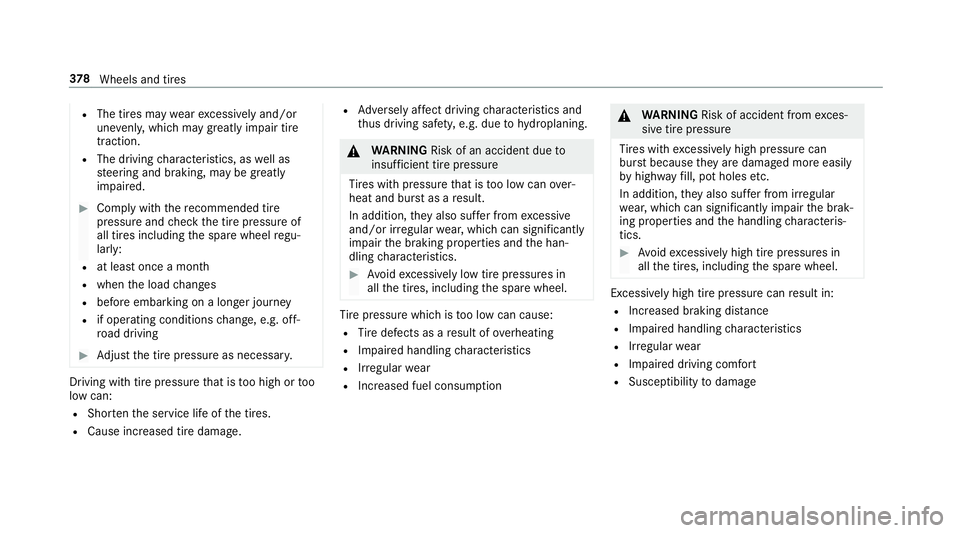
R
The tires may wearexc essively and/or
une venly, which may greatlyimpair tire
traction.
R The driving characteristics, as well as
st eering and braking, may be greatly
impaired. #
Comply with there commended tire
pressure and check the tire pressure of
all tires including the spare wheel regu‐
larly:
R at least once a month
R when the load changes
R before embarking on a lon ger journey
R if operating conditions change, e.g. off-
ro ad driving #
Adjust the tire pressure as necessar y.Driving wi
thtire pressu rethat is too high or too
low can:
R Sho rten the service life of the tires.
R Cause increased tire damage. R
Adversely af fect driving characteristics and
th us driving saf ety, e.g. due to hydroplaning. &
WARNING Risk of an accident due to
insuf ficient tire pressure
Ti re s with pressure that is too low can over‐
heat and bur stas a result.
In addition, they also suf fer from excessive
and/or ir regular wear, which can significantly
impair the braking properties and the han‐
dling characteristics. #
Avoid excessively low tire pressures in
all the tires, including the spare wheel. Ti
re pressure which is too low can cause:
R Tire defects as a result of overheating
R Impaired handling characteristics
R Irre gular wear
R Increased fuel consum ption &
WARNING Risk of accident from exces‐
sive tire pressure
Ti re s with excessively high pressure can
bu rst because they are damaged more easily
by highw ayfill, pot holes etc.
In addition, they also suf fer from ir regular
we ar, which can significantly impair the brak‐
ing properties and the handling characteris‐
tics. #
Avoid excessively high tire pressures in
all the tires, including the spare wheel. Excessively high tire pressure can
result in:
R Increased braking dis tance
R Impaired handling characteristics
R Irre gular wear
R Impaired driving com fort
R Susceptibility todamage 378
Wheels and tires